Treatment
No Surgery
Partial hamstring injuries are most commonly treated without surgery. Initial treatment consists of active rest, oral non-steroidal anti-inflammatory medications (such as Ibuprofen) and a physical therapy program, consisting of a gentle hamstring stretching and a strengthening program. As the initial symptoms go away, exercises can be added in association with a more aggressive hamstring injury prevention program. Full return to sports and activities are allowed when you are asymptomatic. This can take four to six weeks.
If you are unable to progress with this program, an U/S guided corticosteroid injection may be used and has been shown to provide initial relief in up to 50% of patients at one month following a partial tear. A platelet rich plasma (PRP) injection may be suggested by your doctor, instead of a cortisone injection. Failure of nonoperative treatment of partial tears may benefit from surgical clean-up and repair, similar to other commonly seen partial tendon tears in other areas of the body (patella, quadriceps, and biceps).
Nonoperative treatment of complete ruptures of the proximal hamstring is less frequently recommended since surgical repair has been more recognized and has had successful results in several studies. This is especially important in those patients that are highly active. One study identified 12 water skiers with hamstring avulsion injuries, which he treated initially with nonoperative means. It was found that 83% of the patients had persistent cramping or pulling sensation with vigorous activity. Seven patients returned to sports activities but at a lower level. Five patients were only able to do limited activities. Overall, these patients had 61% of hamstring strength deficit and 23% quadriceps deficit. Two of these patients were persistently dissatisfied with their function, eventually leading to delayed surgical repairs.
Surgical Treatment – Arthroscopic
After developing experience in the open management of these injuries, I have developed an endoscopic technique that allows a safe approach to the area of damage in most tears. It is expected that the benefits of a more direct approach, without a large incision should be easier to recover from as well as cause less pain. With the use of endoscopic magnification to protect the sciatic nerve, this treatment also improves the management of these injuries and reduces the problems associated with an open approach.
The technique positions the patient on their belly after being put under anesthesia. The back part of the hip is then sterilized assuring that the leg and thigh are free so that the leg and hip can be re-positioned during surgery.
Two or three incisions are then made as shown in the picture above. Using the arthroscopic equipment that is commonly used for arthroscopy of many other joints, including the hip and shoulder, the area of the hamstring tendon tearing is found. In addition, the sciatic nerve is identified and protected during the case to assure that no damage is done to the area of the nerve.
With the nerve identified and protected tendon edges are cleared of any torn and devitalized tissue and a repair of the tendon is then done using suture material that is anchored to the bone. In some cases, there is ischial bursitis that also has to be removed. In those cases, the bursa will reform after about three months with no residual problems, in most patients.
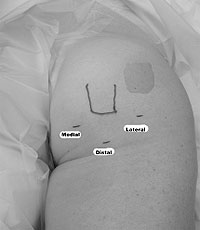
Figure: Position of the patient with the three common incisions
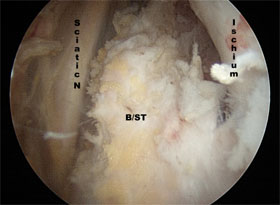
Figure: Photo from Surgical procedure showing the tendon tear (B/ST) from the bone (ischium). To the left, is the Sciatic Nerve that has been exposed to protect it.
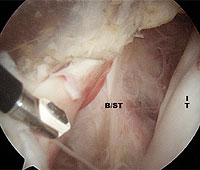
Figure: Area of Tear (B/ST)
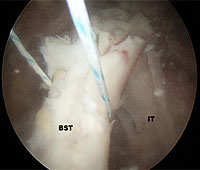
Figure: Sutures in place for Repair
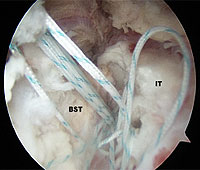
Figure: Anchor holding sutures in place
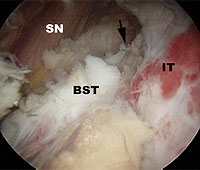
Figure: Final Repair of the Tendon

